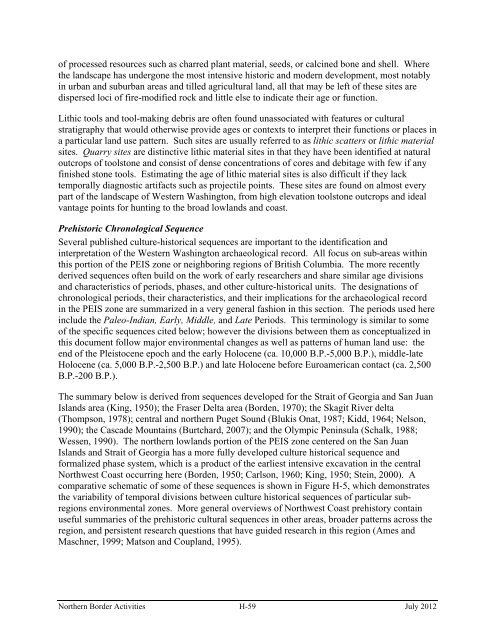Appendix H - Historical Archaeological and ... - CBP.gov
Appendix H - Historical Archaeological and ... - CBP.gov
Appendix H - Historical Archaeological and ... - CBP.gov
You also want an ePaper? Increase the reach of your titles
YUMPU automatically turns print PDFs into web optimized ePapers that Google loves.
of processed resources such as charred plant material, seeds, or calcined bone <strong>and</strong> shell. Where<br />
the l<strong>and</strong>scape has undergone the most intensive historic <strong>and</strong> modern development, most notably<br />
in urban <strong>and</strong> suburban areas <strong>and</strong> tilled agricultural l<strong>and</strong>, all that may be left of these sites are<br />
dispersed loci of fire-modified rock <strong>and</strong> little else to indicate their age or function.<br />
Lithic tools <strong>and</strong> tool-making debris are often found unassociated with features or cultural<br />
stratigraphy that would otherwise provide ages or contexts to interpret their functions or places in<br />
a particular l<strong>and</strong> use pattern. Such sites are usually referred to as lithic scatters or lithic material<br />
sites. Quarry sites are distinctive lithic material sites in that they have been identified at natural<br />
outcrops of toolstone <strong>and</strong> consist of dense concentrations of cores <strong>and</strong> debitage with few if any<br />
finished stone tools. Estimating the age of lithic material sites is also difficult if they lack<br />
temporally diagnostic artifacts such as projectile points. These sites are found on almost every<br />
part of the l<strong>and</strong>scape of Western Washington, from high elevation toolstone outcrops <strong>and</strong> ideal<br />
vantage points for hunting to the broad lowl<strong>and</strong>s <strong>and</strong> coast.<br />
Prehistoric Chronological Sequence<br />
Several published culture-historical sequences are important to the identification <strong>and</strong><br />
interpretation of the Western Washington archaeological record. All focus on sub-areas within<br />
this portion of the PEIS zone or neighboring regions of British Columbia. The more recently<br />
derived sequences often build on the work of early researchers <strong>and</strong> share similar age divisions<br />
<strong>and</strong> characteristics of periods, phases, <strong>and</strong> other culture-historical units. The designations of<br />
chronological periods, their characteristics, <strong>and</strong> their implications for the archaeological record<br />
in the PEIS zone are summarized in a very general fashion in this section. The periods used here<br />
include the Paleo-Indian, Early, Middle, <strong>and</strong> Late Periods. This terminology is similar to some<br />
of the specific sequences cited below; however the divisions between them as conceptualized in<br />
this document follow major environmental changes as well as patterns of human l<strong>and</strong> use: the<br />
end of the Pleistocene epoch <strong>and</strong> the early Holocene (ca. 10,000 B.P.-5,000 B.P.), middle-late<br />
Holocene (ca. 5,000 B.P.-2,500 B.P.) <strong>and</strong> late Holocene before Euroamerican contact (ca. 2,500<br />
B.P.-200 B.P.).<br />
The summary below is derived from sequences developed for the Strait of Georgia <strong>and</strong> San Juan<br />
Isl<strong>and</strong>s area (King, 1950); the Fraser Delta area (Borden, 1970); the Skagit River delta<br />
(Thompson, 1978); central <strong>and</strong> northern Puget Sound (Blukis Onat, 1987; Kidd, 1964; Nelson,<br />
1990); the Cascade Mountains (Burtchard, 2007); <strong>and</strong> the Olympic Peninsula (Schalk, 1988;<br />
Wessen, 1990). The northern lowl<strong>and</strong>s portion of the PEIS zone centered on the San Juan<br />
Isl<strong>and</strong>s <strong>and</strong> Strait of Georgia has a more fully developed culture historical sequence <strong>and</strong><br />
formalized phase system, which is a product of the earliest intensive excavation in the central<br />
Northwest Coast occurring here (Borden, 1950; Carlson, 1960; King, 1950; Stein, 2000). A<br />
comparative schematic of some of these sequences is shown in Figure H-5, which demonstrates<br />
the variability of temporal divisions between culture historical sequences of particular subregions<br />
environmental zones. More general overviews of Northwest Coast prehistory contain<br />
useful summaries of the prehistoric cultural sequences in other areas, broader patterns across the<br />
region, <strong>and</strong> persistent research questions that have guided research in this region (Ames <strong>and</strong><br />
Maschner, 1999; Matson <strong>and</strong> Coupl<strong>and</strong>, 1995).<br />
Northern Border Activities H-59 July 2012
















